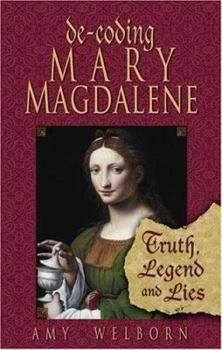Decoding Mary Magdalene: Truth, Legend, and Lies
Examines myths and misconceptions about Mary Magdalene and her role in early Christian history and draws on scripture and modern scholarship to reveal her as an important witness to the resurrection... This description may be from another edition of this product.
Format:Paperback
Language:English
ISBN:1592762093
ISBN13:9781592762095
Release Date:January 2006
Publisher:Our Sunday Visitor
Length:141 Pages
Weight:0.80 lbs.
Dimensions:0.3" x 6.1" x 7.8"
Customer Reviews
1 rating
A Brief, yet thorough treatment, of Mary Magdalene
Published by Thriftbooks.com User , 18 years ago
Due to "The Da Vinci Code," Mary Magdalene has received a great deal of attention lately. Unfortunately, much of what people have been saying about her is based in myth and legend. Amy Welborn, who has a Masters degree in Church History, sets out to lay the record straight in "de-coding Mary Magdalene: Truth, Legend, & Lies" Welborn begins with what the four canonical Gospels have to tell us about Mary Magdalene. "The four Gospels in the New Testament have been accepted as the most authoritative and accurate writings on Jesus' life since the early second century." Welborn is quick to point out that those who refute the Gospels' accuracy on the basis of time or distance from the events they depict, are often eager to hold up another work as truth (most often one of the Gnostic gospels) which were actually written later. One of the unique features of Mary Magdalene is that she is identified "not by her relationship to a man, as most women would be at that time, but to a town . . . she was a single woman, able to give support to Jesus out of gratitude for what he had done for her." Welborn also emphasizes the important point that Mary Magdalene was never associated with sinfulness in the Gospels. She was a woman possessed, and at this time, possession had nothing to do with sin. She was however at the margins of society, until Jesus came along and saved her. She would then go on to be one of his most faithful followers, being among the first to bear witness to the Resurrection. Welborn does spend some time discussing the Gnostic writings and what they have to say about Mary. She makes the interesting point that in these writings, the Mary being spoken of is not identified as Mary Magdalene. It is possible they are speaking of Mary, the Mother of Jesus, or even an amalgamation of several of the Marys who are so prevalent in scripture. The Gnostic texts are the source of the popular idea that there was a battle for power in the early Church between Peter and Mary Magdalene. Welborn maintains that there is no evidence that these Gnostic texts represent actual events that happened in the first century. They were separated from those events by at least a century, and present a radically different view of events than the canonical Gospels and other New Testament writings which were composed much earlier. They tell us a great deal about the Gnostic view of life but almost nothing about the persons of Jesus, Mary Magdalene, or the other Apostles. Welborn then turns her attention to how the Catholic Church has imaged Mary of Magdalene through the centuries. The early Church Fathers regarded her as "Apostle to the Apostles," a moniker which has been retained in the Eastern Church. In the West, things got a little murky when Pope Gregory I confused Mary Magdalene with the unnamed penitent women in Luke 7. He was not seeking to demean her, however, but rather to hold her up as an example of repentance. The idea of the Church waging a mass media campaig





